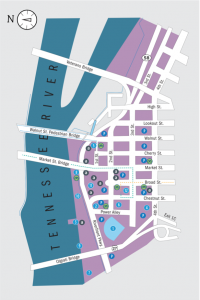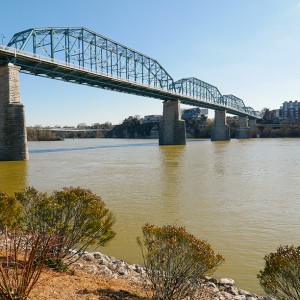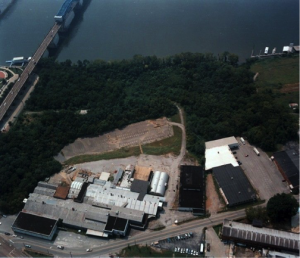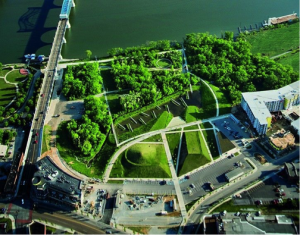
Urban Chattanooga is subject to pollution from its industrial past when residential neighborhoods were proximate to toxic waster sites and the air quality so bad that people drove with headlights on in the daytime. In 1984, Chattanooga Venture united resident and came up with plans to improve the city. Chattanooga went through a “renaissance” from the hands of landscape designers and planners.
In our field trip, we briefly walked through the riverfront park, sat down for a lunch, observed activities, and walked along the Tennessee River and under the famous Walnut Street Bridge. We enjoyed some public art and recreational facilities, including a set of band instruments inviting passer-by to interact and a cleverly installed rock-climbing wall on side of supporting structure of bridge. We also saw people sketching the stylish architecture on the other side of the river. The facilities on the riverfront were painted in appealing and matching colors and movable chairs made it easy to gather and socialize. There were splashable water which was noted by William Whyte as a contributing element to the social life of public spaces.

Chattanooga’s $120 million redevelopment stretches to 130 acres on both sides of the Tennessee River. The 21st Century Riverfront connects downtown redevelopment into a network. The Downtown plan was to design the Riverfront to be a live, work, play mixed use zone that attract visitors, investors and home buyers. The Riverfront is an extensive area with four bridges, Riverfront Pkwy, and stretches from Chestnut St. to beyond High St. There are 13 mile linear park trails, picnic areas, playgrounds, fishing piers and wetlands. The commercial and public places include AT&T Field, Chattanooga Green, Chattanooga Pier, Creative Discovery Museum, First Street Sculpture Garden, IMAX Theater, Marina, The Passage, Riverboat Attractions, Ross’s Landing Park, Tennessee Aquarium, and Visitors Center. Transportation options are numerous. The whole area has a connected network of public parking, riverwalk, shuttle routes, public arts and bike sharing stations.
The most important characteristic of Chattanooga Riverfront is the adaptive reuse projects. An old theatre was turned into urban centerpiece. A “retired” bridge was turned into the “hip” pedestrian bridge. A polluted industrial site was turned into a wetland park. The Riverfront has a wide range of functions. It provides gathering spaces, opportunities for exercise, relaxation and wildlife viewing. Boat ramps enable activities for kayaks and canoes. Tennessee Aquarium’s conservation efforts are compounded by educational promotions of recycling, energy-efficient appliances and reusing water. Piers have interpretive signs that illustrate the culture history and storm water treatment process. Many restaurants in the Riverfront offer Farm to Table meals.


Renaissance Park on Chattanooga Riverfront is similar to the Old Fourth Ward park on Atlanta Beltline: both jumpstarted cultural and environmental restoration in areas once blighted by urban decay. In both sites, there are recreational features and boardwalk that provides the visitors with an intimate experience with nature. Both projects were big on the collaboration of public and private sectors. For Old Fourth Ward, it is the collaboration between the Beltline and City of Atlanta Department of Watershed Management. For Renaissance Park, it is the collaboration between The Audubon Society, the TDEC, U.S. Army Corps of engineers etc. Both parks collect, improve and release water from storm water runoff and water from sewers. Both sites provide the link between the land and the water and have wet-forest with native species. Having being to both places, I would say they are also both beautiful outdoor space with commercial opportunities and tourist attraction appeal.
The success of Chattanooga Riverfront seems to encourage the non-profit, City of Chattanooga, private landowners to go even further in transforming Downtown Chattanooga and taking advantages of the growth already in place. The city is boasting more and more LEED Certified buildings, providing free electric shuttle, and installing more bike sharing stations. Volkswagen Group of America opened their only U.S. Manufacturing facility in Chattanooga. The site is the world’s first LEED Platinum auto assembly plant.
Authored by Liu Yang
Works Cited
“Downtown Chattanooga – Riverfront.” Downtown Chattanooga – Riverfront. Web.
“Renaissance Park.” Landscape Performance Series. 2014. Web.
“Chattanooga, TN Sustainability Plan.” – Green Policy. Web.